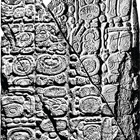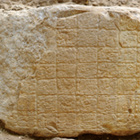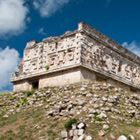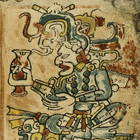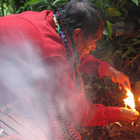Primer: Three Maya Calendars
December/January 2013
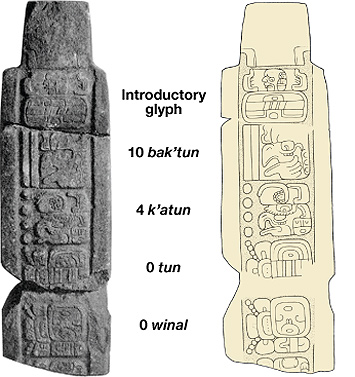 The Maya calendar that records the longest span of time is called the Long Count. It marks the number of days that have passed since a mythological founding date that fell on either August 11 or 13, 3114 B.C., depending on how the Maya calendar is reconciled with our calendar. Long Count dates are usually written as a series of five numbers, such as 7.17.18.13.3 (the date that corresponds to January 1, A.D. 1). The smallest unit of time is the day, or k’in, and it is recorded in the place farthest to the right. The next place records the number of winals, a 20-day unit of time often referred to as a “Maya month.” The third place records the number of Maya years called tuns. Eighteen winals make up a tun, for a total of 360 days. The Maya extended the count by multiplying each successive cycle by 20. Thus, 20 tuns make up a k’atun, and 20 k’atuns make up a bak’tun—a period of time equivalent to 394.52 solar years.
The Maya calendar that records the longest span of time is called the Long Count. It marks the number of days that have passed since a mythological founding date that fell on either August 11 or 13, 3114 B.C., depending on how the Maya calendar is reconciled with our calendar. Long Count dates are usually written as a series of five numbers, such as 7.17.18.13.3 (the date that corresponds to January 1, A.D. 1). The smallest unit of time is the day, or k’in, and it is recorded in the place farthest to the right. The next place records the number of winals, a 20-day unit of time often referred to as a “Maya month.” The third place records the number of Maya years called tuns. Eighteen winals make up a tun, for a total of 360 days. The Maya extended the count by multiplying each successive cycle by 20. Thus, 20 tuns make up a k’atun, and 20 k’atuns make up a bak’tun—a period of time equivalent to 394.52 solar years.
Maya monuments that have Long Count dates often include dates from other types of calendars. The two most important of these time cycles are the tzolk’in, a 260-day cycle that may be based on the duration of a human pregnancy, and the haab, a calendar that approximates the solar year. One example of an artifact that includes dates from all three calendars is monument six from the site of Tortuguero. An inscription on that monument mentions the date at the end of the thirteenth bak’tun, which falls on December 23, 2012, written as 13.0.0.0.0 4 Ajaw 3 K’ank’in by the ancient Maya.
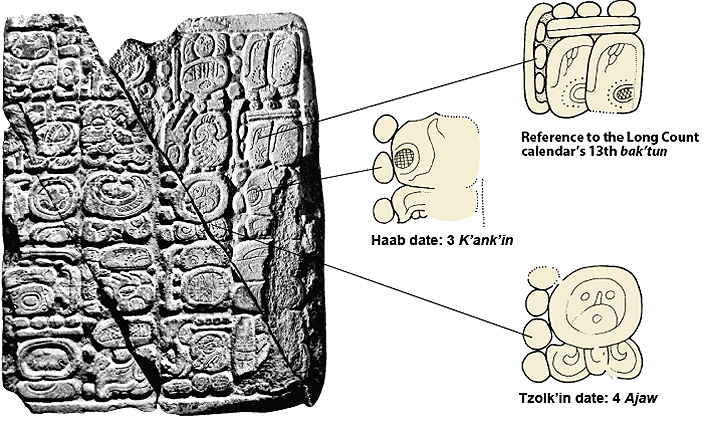
The date 4 Ajaw records the day in the tzolk’in calendar. The tzolk’in is based on a 13-day “week.” The number 4 in the date records the day of the week. There are also 20 named days, so each day has a name and a number. The first named day is Imix, which translates as “water serpent” in Yukatek Mayan, followed by Ik’ (“wind”), and Ak’bal (“night”). The numbers run concurrently with the names, so the first day of the tzolk’in calendar is 1 Imix, followed by 2 Ik’, and then 3 Ak’bal. After day 13 is reached, the numbers start over but the names continue, therefore the fourteenth day of the tzolk’in is called 1 Ix (“jaguar”). This cycle continues for 260 days, when the calendar returns to 1 Imix. The twentieth day name, and the one mentioned in the Tortuguero monument, is Ajaw (“lord”), which was the day when many important festivals commemorating period endings were celebrated.
The date “3 K’ank’in” refers to a day in the haab calendar, which is based on the solar year. Each day in the haab is numbered from zero to 19 and occurs during one of 18 named months called a winal. The first day of the haab is called 0 Pop, the second day is 1 Pop, etc., up to 19 Pop. The twenty-first day of the haab is 0 Wo. The 18 winals add up to 360 days. The remaining five days of the solar year were called Wayeb, and were considered a time of bad luck. The Maya did not include a leap day in the haab calendar, so it would diverge from our modern calendars by one day every four years.
The tzolk’in and haab calendars were also used together in what is called the “Calendar Round.” Starting at 1 Imix 0 Pop, it takes 52 haab years or 73 tzolk’in cycles for the two calendars to come around again to that date. The last calendar round was completed on April 28, 2011. The next one will end on April 15, 2063.
Advertisement
IN THIS ISSUE
From The Trenches
The Desert and the Dead
Fractals and Pyramids
Off the Grid
Mosaics of Huqoq
Medieval Fashion Statement
The Bog Army
Who Came to America First?
Settling Southeast Asia
Livestock for the Afterlife
Running Guns to Irish Rebels
High Rise of the Dead
Diagnosis of Ancient Illness
Pharaoh’s Port?
Peru’s Mysterious Infant Burials
Advertisement

Recent Issues
-
 May/June 2024
May/June 2024
-
 March/April 2024
March/April 2024
-
 January/February 2024
January/February 2024
-
 November/December 2023
November/December 2023
-
 September/October 2023
September/October 2023
-
 July/August 2023
July/August 2023
-
 May/June 2023
May/June 2023
-
 March/April 2023
March/April 2023
-
 January/February 2023
January/February 2023
-
 November/December 2022
November/December 2022
-
 September/October 2022
September/October 2022
-
 July/August 2022
July/August 2022
-
 May/June 2022
May/June 2022
-
 March/April 2022
March/April 2022
-
 January/February 2022
January/February 2022
-
 November/December 2021
November/December 2021
-
 September/October 2021
September/October 2021
-
 July/August 2021
July/August 2021
-
 May/June 2021
May/June 2021
-
 March/April 2021
March/April 2021
-
 January/February 2021
January/February 2021
-
 November/December 2020
November/December 2020
-
 September/October 2020
September/October 2020
-
 July/August 2020
July/August 2020
-
 May/June 2020
May/June 2020
-
 March/April 2020
March/April 2020
-
 January/February 2020
January/February 2020
-
 November/December 2019
November/December 2019
-
 September/October 2019
September/October 2019
-
 July/August 2019
July/August 2019
-
 May/June 2019
May/June 2019
-
 March/April 2019
March/April 2019
-
 January/February 2019
January/February 2019
-
 November/December 2018
November/December 2018
-
 September/October 2018
September/October 2018
-
 July/August 2018
July/August 2018
-
 May/June 2018
May/June 2018
-
 March/April 2018
March/April 2018
-
 January/February 2018
January/February 2018
-
 November/December 2017
November/December 2017
-
 September/October 2017
September/October 2017
-
 July/August 2017
July/August 2017
-
 May/June 2017
May/June 2017
-
 March/April 2017
March/April 2017
-
 January/February 2017
January/February 2017
-
 November/December 2016
November/December 2016
-
 September/October 2016
September/October 2016
-
 July/August 2016
July/August 2016
-
 May/June 2016
May/June 2016
-
 March/April 2016
March/April 2016
-
 January/February 2016
January/February 2016
-
 November/December 2015
November/December 2015
-
 September/October 2015
September/October 2015
-
 July/August 2015
July/August 2015
-
 May/June 2015
May/June 2015
-
 March/April 2015
March/April 2015
-
 January/February 2015
January/February 2015
-
 November/December 2014
November/December 2014
-
 September/October 2014
September/October 2014
-
 July/August 2014
July/August 2014
-
 May/June 2014
May/June 2014
-
 March/April 2014
March/April 2014
-
 January/February 2014
January/February 2014
-
 November/December 2013
November/December 2013
-
 September/October 2013
September/October 2013
-
 July/August 2013
July/August 2013
-
 May/June 2013
May/June 2013
-
 March/April 2013
March/April 2013
-
 January/February 2013
January/February 2013
-
 November/December 2012
November/December 2012
-
 September/October 2012
September/October 2012
-
 July/August 2012
July/August 2012
-
 May/June 2012
May/June 2012
-
 March/April 2012
March/April 2012
-
 January/February 2012
January/February 2012
-
 November/December 2011
November/December 2011
-
 September/October 2011
September/October 2011
-
 July/August 2011
July/August 2011
-
 May/June 2011
May/June 2011
-
 March/April 2011
March/April 2011
-
 January/February 2011
January/February 2011
Advertisement




